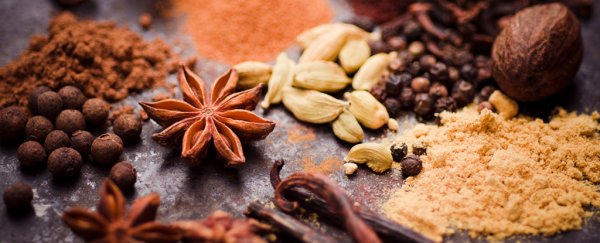There are many flavours associated with Christmas: cinnamon, mint, nutmeg, and, of course, sage. But before you head to your local supermarket or pop online to grab these all-important herbs and spices, how sure are you that they're genuine?
As researchers of food safety, this is what we seek to investigate. Not only did we previously find that oregano was being cut with non-food ingredients, we've recently uncovered that sage – one of the most popular seasonings at Christmastime – might be less genuine than expected, too.
To understand how spices can be adulterated, it's important to understand the monetary value of many herbs and spices.
Often we can buy these cheaply from retailers. But when we compare the price per kilogram, some of the most expensive spices – such as vanilla and saffron – trade for almost the same price as silver and gold.
With such value comes the massive issue of fraud. Vast fortunes can be made in cheating on herbs and spices in this complex, multi-billion pound industry.
The words "adulteration" and "herbs and spices" are often closely linked, and cheating occurs in many parts of the world. Similar to illicit drugs, these food ingredients can pass through many hands and can be cut with low value, nonfood materials.
For herbs, this can be any green leaves that are available in large quantities. For spices, they can be cut with anything from brick dust to highly toxic industrial dyes. These added materials could potentially be harmful to our health.
Uncovering fraud
Our interest in the murky world of fraudulent herbs and spices began back in 2014 when we received a tip that some dried oregano on sale in the UK market was adulterated. This was the start of a journey to understand how the fraud operates and find innovative ways of detecting it.
Our team started to develop "chemical fingerprints" of oregano using a scientific technique known as molecular spectroscopy. This can produce chemical fingerprints of many types of food ingredients.
This, alongside the use of clever statistical techniques known as "chemometrics" (which extracts information from the data we've given it) allowed us to scan oregano and find out within a few seconds if it had been adulterated.
When we applied this technique to around 100 samples purchased in the UK from large and small retailers as well as online sellers, we were astounded to find that 25 percent of all the oregano on sale in the UK was adulterated with substances such as olive leaves and myrtle leaves.
Our story went viral and we received samples of oregano from all over the world. In some countries – namely South Africa and Australia – the rate of adulteration was well over 50 percent. This study sent shock-waves across the food industry and authorities and huge efforts were put in place to stamp out the fraud.
Recently we went back to test the UK marketplace and only one sample of 20 was found to be adulterated – indicating that our work had triggered much better quality control of this herb.
Fake sage
But our story does not end here.
We received a tip-off recently that dried sage, the herb we all associate with Christmas, was also subject to adulteration. Using the same chemical fingerprinting technique we went out to sample and test again.
Once more we found adulteration, with 25 percent of all samples tested adulterated. Because of lockdown in the UK, we were limited to buying around 20 samples, from large and small stores, as well as several large online marketplaces, all of which were sourced from within the UK.
Some ingredients that have been used to adulterate sage include olive leaves, myrtle leaves, sumac, hazelnut leaves, and strawberry tree leaves.
The big difference this time was that all the adulterated samples were purchased from either small stores or online sellers. Products from major retailers were all 100 percent genuine.
Our interpretation of this data is that large retailers have tighter controls, whereas small stores don't. The issue of online adulteration is more substantial however, as many of the products could be bought from large platforms that many of us use frequently.
We realise our battle against the fraudsters is far from over and they will try everything and anything to keep their lucrative and illicit trade operating. But the weapons we are using to find the cheats keep improving.
Our latest breakthrough has been to employ tiny handheld scanners linked to smartphones to scan for adulteration. This means that, in the future, testing can happen anywhere globally at any point in a supply chain. We have launched our own technology company to deploy this form of testing alongside numerous leading herb and spice manufacturers and retailers.
Our fight against fraud in the food industry continues and our technology will make it much more difficult for the fraudsters to keep operating. But the best way to protect yourself in the meantime is to only buy spices and herbs from reputable sources – and if you're offered something that's too good to be true price-wise, there's a good chance it may be fake. This will ensure you're buying the best product that isn't laced with dangerous chemicals.![]()
Chris Elliott, Professor of Molecular Biosciences, Queen's University Belfast and Simon Haughey, Senior research fellow, Queen's University Belfast.
This article is republished from The Conversation under a Creative Commons license. Read the original article.
